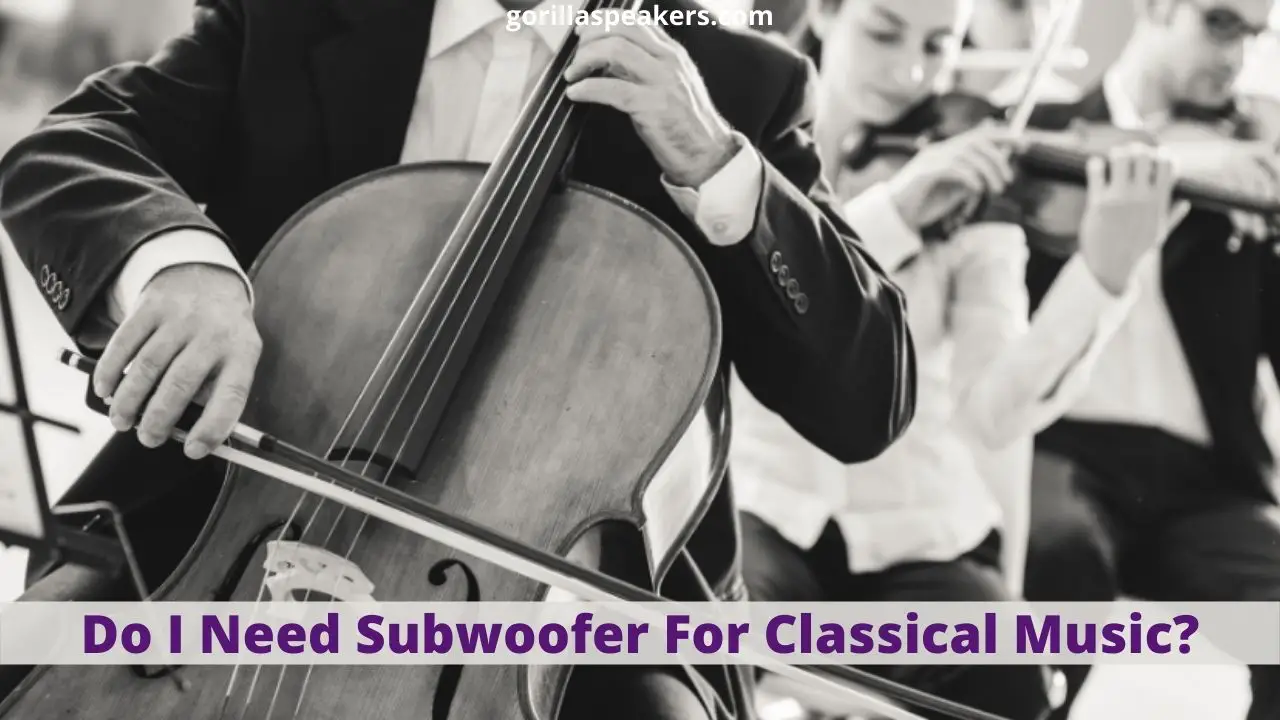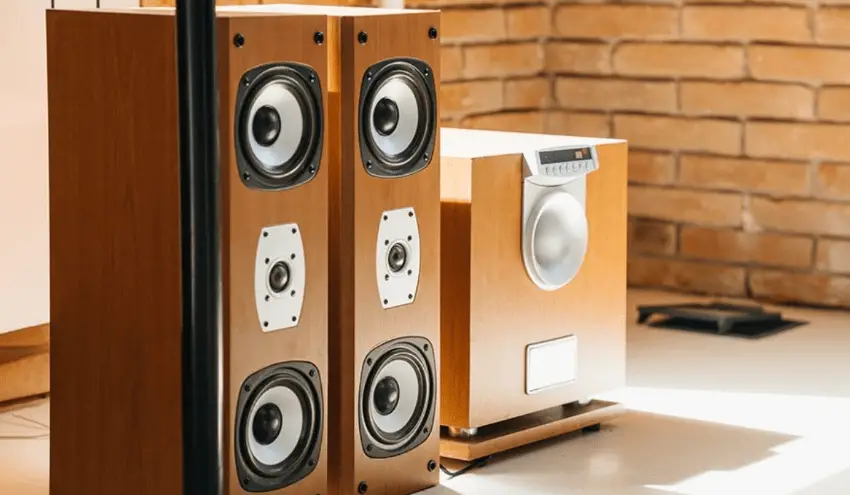If you enjoy listening to classical music through a speaker, you may be missing out on some of the deeper notes and frequencies!
Because standard speakers can not play low frequencies so, you need something that can play those low frequencies required for classical music deep bass notes.
A Subwoofer is a must-have in this case!
A subwoofer is absolutely a good choice for classical music and also for low attenuation sound. This is dependent on your system; it must be truly full range, with excellent coherence and natural tonality.
So, Without any further ado, let us look at how subwoofers play a significant role in classical music!
Do You Need A Subwoofer For Classical Music?
If you are listening to classical music on your stereo system, it may sound quite good to a normal listener. Still, if you are into classical music, you know that normal speakers aren’t able to give the output of all the sounds and instruments played in classical music.
That is because you are missing a major element in your stereo system, that is, a Subwoofer.
A subwoofer is a speaker that is dedicated to the reproduction of low-pitched audio frequencies, most commonly referred to as bass, having a frequency range between 20-200 Hz.
As they are intended to augment the low-frequency range of loudspeakers that cover the higher frequency bands, it works well with classical music.
It’s difficult to demonstrate a subwoofer for classical music in the showroom because the sub is usually set too high.
You must be familiar with your main speakers and understand their limitations because all the bass should sound like it’s coming from speakers. As stated by Andolink, a subwoofer should not draw attention to itself.
While most good full-range speakers can handle the majority of this, a “real” subwoofer can add a sense of feel to your classical music.
It’s just a delicate balance between having too much bass and not adding anything to the music.
One thing to keep in mind is that classical music is pretty much immune to the modern digital mastering pestilence of final compression to make the track sound louder.
So, when mastering dynamic classical music, your stereo image and signal peaks should be preserved to the greatest extent possible.
Will A Subwoofer Help To Make A “Deep, Warm” Sound For Classical Music?
Of course, A good subwoofer is a must have to fully enjoy the Deep, Warm sound of classical music.
Classical music is much more than big symphonic music featuring tubas and double basses or organ chorales! that is why it requires something to play those deep notes which is only possible through a subwoofer.
A good subwoofer will reproduce the low bass of the double bass section, cellos, and orchestral bass drums, and tuba, so it’s necessary if your main speakers can’t handle 40 Hz effectively.
So that means, If you don’t hear the low frequencies, you are missing something. All types of music, particularly classical music, have high value fidelity and flat frequency response.
This means the natural dynamics are still there allowing you to use the volume to hit a normal level, and when the timpani rolls in, the dynamic remains intact in its natural form.
Then you will hear and feel those organ pedals gently interacting with the acoustic at 15hz. The sub helps the entire sound stage and harmonics sound better, not just the bottom end.
While playing Orchestra connected with a subwoofer, you can feel the double bass vibrations on the floor.
The only thing to be pondered is that music should never sound fake. It should be gentle, and the bass drum should be felt in the chest with no distortion.
Deep bass requires a lot of excursions as you get louder, and you may find that the bass cannot keep up if you play loudly.
A sub that is flat or at least down to 20 Hz and capable of whatever SPL you need is likely to be a revelation on at least some recordings.
And with classical music, one should probably seek as true a sound (true to what was recorded) as possible!
Types Of Classical Music That Need A Subwoofer
The most popular types of classical music that require a subwoofer to get the best sound are listed below.
Symphony:
A large ensemble of string, brass, wind, and percussion players is referred to as a “symphony” in the broadest sense. Because a symphony is a piece written specifically for this ensemble, a subwoofer should be used to produce the best warm and deep sound.
A symphony orchestra is simply a large group of musicians. (Occasionally, a “back-up orchestra” for a jazz singer is mentioned, but it is usually much smaller than a classical orchestra.)
When a town has several large groups, the term “philharmonic” is frequently used to differentiate them.
Concerto:
It’s a large-scale work for a full orchestra as well as an instrumental soloist.
This is usually a piano, violin, or cello, but it can also be an orchestral instrument that falls under the category of music that can be played on a subwoofer.
A concerto gives the soloist and the orchestra a chance to show off their interactive and collaborative skills.
Both require some bass when playing that sound, which can be achieved with the use of a subwoofer.
Almost every symphony concert will feature a concerto, and all symphony presenters strive to book the most glitzy soloist for their fall opening night concerts.
Opera:
Operas are very large scale pieces that are a mixture of music and theatre.
Operas typically feature a full orchestra, solo singers, and a choir that must both act and sing.
Operas can be enjoyed solely for their musical content. Due to the fact that operas are performed in theatres, subwoofers should be used to achieve the crisp and bass in the dramatic music.
Chamber Music:
Chamber music is for a small group of listeners. More precisely, it is for a small group of performers, ranging from one (e.g., a sonata) to about six or eight (a sextet and octet).
They can include any type of instrument in combination, and the focus again is on the interplay between the instruments and those all instruments play deep bass that can only be heard clearly through a subwoofer.
Classical Music Instruments That Demand Subwoofers
The following are the classical music instruments for which you should consider purchasing a subwoofer.
Cello:
Cello is a bowed string instrument of the violin family, and the frequency of this instrument ranges 65.4Hz. Music for the cello is generally written in the bass clef, with tenor clef, or alto clef, and treble clef used for higher-range passages
Simple bass guitar is tuned in fourth (low to high E, A, D, G) while the cello is tuned in fifths (C, G, D, A). Playing these instruments is very different as a result of this.
Some bassists try tuning the bass in fifths like a cello – and enjoy it – either an octave below the cello (on a 34′′ bass) or using the cello pitch (on a shortscale), which is why they mostly use a subwoofer to play those deep bass sounds.
Its four strings are usually tuned in perfect fifths: C2, G2, D3, and A3 from low to high.
Each of the viola’s four strings is an octave higher.
Double Bass:
Also known simply as the bass, it is the largest and lowest-pitched bowed string instrument in the modern symphony orchestra.
Double bass has a frequency of 41.2 Hz, which corresponds to the type of music that should be played on a subwoofer.
Its structure is similar to that of the cello. It has four strings, but there are times when it has five.
Bassoon:
A bassoon is a woodwind instrument in the double reed family, which plays in the tenor and bass ranges.
It is composed of six pieces and is usually made of wood. It has a frequency of 58.3 Hz, which necessitates the use of a subwoofer.
It is known for its distinctive tone color, wide range, versatility, and virtuosity.
Trombone:
It is a musical instrument in the brass family which demands a subwoofer with it to be played accurately.
The player’s vibrating lips cause the air column inside the instrument to vibrate, as it does with all brass instruments.
It is played on a frequency of 82.4 Hz.
Most brass instruments use valves to alter the pitch, but trombones have a telescoping slide mechanism instead.
What Kind Of Subwoofer Is Fitable For Classical Music?
The type of subwoofer specified for Classical Music depends on your System and budget!
All in all, a subwoofer is an essential part of your system. A subwoofer that is able to reproduce frequencies all the way down to 20Hz and below, known as infrasonic frequencies, with plenty of volumes.
Properly designed subwoofers produce the correct amount of bass output at the right frequencies at just the right moment to achieve a harmonious listening experience.
Aside from low-frequency extension down to 20 Hz or lower, a good subwoofer should pump out those frequencies at high sound pressure levels (SPLs) that rattle your bones.
And it must reproduce those frequencies accurately without adding any distortion; to test this, be sure to listen to super-smooth, super-low bass.
Also, it must respond to the all-important transients with lighting speed to do justice to fast-moving and rapid-fire bass.
If you’re on a budget for your home-theater development, start with just one subwoofer. As your system grows, think about adding a second low-toned beast to your setup.
Benefits Of Adding A Subwoofer For Classical Music?
The subwoofer blends seamlessly with your main speakers, which extends the frequency range of the entire system up to 20kHz or even higher. The subwoofers can faithfully reproduce the full audible range.
A high-quality subwoofer creates a wide and deep soundstage in front of you, with the sound of each classical instrument coming from a distinct location.
There are many more worthy tracks that really test the mettle of your subwoofer and speakers, so give a listen!
CONCLUSION
Here we came to know how subwoofers play a vital role in Classical Music by adding bass, depth and clarity to your music that you would otherwise miss out on with a standard stereo system!



